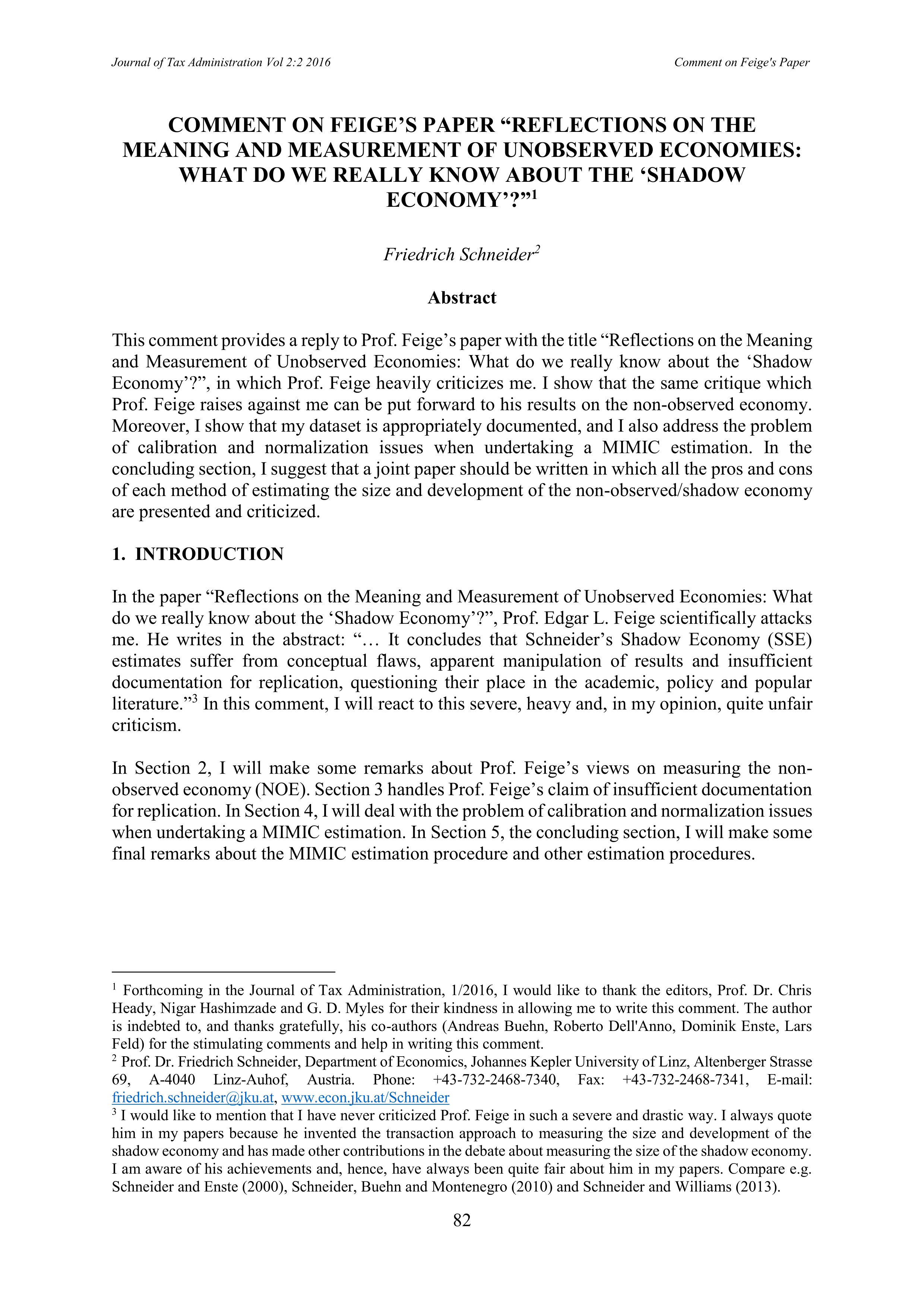Comment on Feige's Paper "Reflections on the Meaning and Measurement of Unobserved Economies: What Do We Really Know About the 'Shadow Economy'?
Abstract
This comment provides a reply to Prof. Feige’s paper with the title “Reflections on the Meaning and Measurement of Unobserved Economies: What do we really know about the ‘Shadow Economy’?”, in which Prof. Feige heavily criticizes me. I show that the same critique which Prof. Feige raises against me can be put forward to his results on the non-observed economy. Moreover, I show that my dataset is appropriately documented, and I also address the problem of calibration and normalization issues when undertaking a MIMIC estimation. In the concluding section, I suggest that a joint paper should be written in which all the pros and cons of each method of estimating the size and development of the non-observed/shadow economy are presented and criticized.
References
Bajada, C. and Schneider, F. (2005). The Shadow Economies of the Asia-Pacific. Pacific Economic Review, 10(3), 379-401.
Breusch, T. (2005). Estimating the Underground Economy using MIMIC Models, Australian National University. Working Paper, Canberra. Retrieved from: http://econ.unimelb.edu.au/SITE/workshops/Breusch.pdf.
Dell’Anno, R. and Schneider, F. (2003). The Shadow Economy of Italy and other OECD countries: What do we know? Journal of Public Finance and Public Choice, 21(2-3), 97-120.
Enste, D.H. and Schneider, F. (2006). Welchen Umfang haben Schattenwirtschaft und Schwarzarbeit? Ein Versuch zur Lösung des Rätsels, Wirtschaftsdienst, 2006/3, 185-191.
Feige, E.L. (2016). Reflections on the Meaning and Measurement of Unobserved Economies: What do we really know about the “Shadow Economy”? Journal of Tax Administration, 1/2016.
Feige, E.L. and Urban, I. (2008). Measuring Underground (Unobserved, Non-Observed, Unrecorded) Economies in Transition Countries: Can We Trust GDP? Journal of Comparative Economics, 36(2), 287-306.
Feld, L.P. and Larsen, C. (2005). Black Activities in Germany in 2001 and 2004: A Comparison Based on Survey Data, Study Nr. 12. Copenhagen: The Rockwool Foundation Research Unit.
Feld, L.P. and Larsen, C. (2012a). Undeclared Work, Deterrence and Social Norms: The Case of Germany. Berlin/Heidelberg: Springer-Verlag.
Feld, L.P. and Larsen, C. (2012b). Self-Perceptions, Government Policies and Tax Compliance in Germany. International Tax and Public Finance, 19, 78-103.
Kazemier, B. (2006). Monitoring the Underground Economy: A Survey of Methods and Estimates. In Schneider, F. and D. Enste (Eds.), Jahrbuch Schattenwirtschaft 2006/07. Zum Spannungsfeld von Politik und Ökonomie, (pp. 11-53). Berlin: LIT Verlag.
OECD, Organization for Economic Co-operation and Development. (2002). Measuring the Non-Observed Economy: A Handbook (pp.1-249). Paris, France: OECD Publications Service. 1-249.
Pedersen, S. (2003). The Shadow Economy in Germany, Great Britain and Scandinavia. Copenhagen: The Rockwool Foundation Research Unit.
Schneider, F. (2015). Schattenwirtschaft und Schattenarbeitsmärkte: Die Entwicklung der letzten 20 Jahre. Perspektiven der Wirtschaftspolitik (PWP), 16(1), 3-25.
Schneider, F. and Enste, D. (2000). Shadow economies: Size, causes and consequences. Journal of Economic Literature, 38/1, 73-110.
Schneider, F. and Williams, C.C. (2013). The Shadow Economy. London: Institute for Economc Affairs (IEA).
Schneider, F., Buehn, A. and Montenegro, C.E. (2010). New Estimates for the Shadow Economies all over the World. International Economic Journal, 24/4, 443-461.
Schneider, F., Krstić, G., Arsić, M. and Randelović, S. (2015). What Is the Extent of the Shadow Economy in Serbia? In G. Krstić, and F. Schneider (Eds.), Formalizing the Shadow Economy in Serbia, (pp. 47-76). Heidelberg: Springer-Verlag.
Thomas, J.J. (1992). Informal Economic Activity. Ann Arbor: The University of Michigan Press.
UN, United Nations Economic Commission for Europe (2008). Non-Observed Economy in national Accounts: Survey of Country Practices (pp.1-340).Geneva, Switzerland.
Williams, C.C. and Schneider, F. (2016). Measuring the Global Shadow Economy: The Prevalence of Informal Work and Labour. Cheltenham (UK): Edward Elgar Publishing.

Downloads
Published
How to Cite
Issue
Section
License
Copyright (c) 2016 Friedrich Schneider

This work is licensed under a Creative Commons Attribution 4.0 International License.
Our open access status means that authors retain the copyright of their work. However, all papers published in JOTA are done so under a Creative Commons Attribution 4.0 International license (CC BY). This means that others can share and/or adapt your work without your permission as long as they follow certain rules, including attributing your work correctly.
You can learn more about this on our Open Access, Licensing, and Copyright Policies page.



